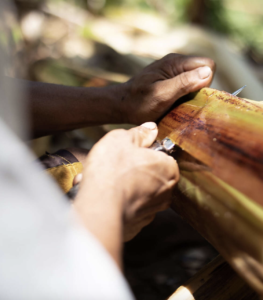I left Wednesday’s debate feeling slightly conflicted. My team was meant to argue in favor of the proposal, have designers come to terms with their impact on the environment…. What I found interesting about the process of preparing my arguments was that I actually agreed (quite strongly) with the opposition. While researching I uncovered both appalling and hopeful practices, but what I really enjoyed was the exposure to some really fascinating ideas and products stemming from designers’ actions regarding the environment.

Looking at the fashion industry seemed like a good place to start finding deplorable standards, practices, and designers shirking their responsibilities. Beginning with an opinion piece in the New York Times about “fast-fashion”, I learned that in this new business model 66% of textiles end up in a landfill while another 19% are destroyed at the end of their lifecycle. (Greenley 2022). While I was able to find loads of information on damaging areas of the business, no one person was named as the culprit. I continued to find more damming statistics regarding emissions, with 10% of global emissions being released by the fashion industry. (news.cgtn.com) But again, no mention of a name or a single person (or group) to blame. The more I researched the more I began to see the real culprit is the Capitalist machine driving commerce at the expense of the planet and people.
The hopeful part of my research came from the innumerable people doing innovative things on the small and large scale. One of my opposing classmates mentioned designer Stella McCartney who embraces all aspects of environmental stewardship – from biodegradable material made from banana plants to forest-friendly viscose. (McCartney 2023) Each area of focus is clearly stated on the website with substantial descriptions devoted to evidencing that this is not a marketing ploy. Another company that I thought of and personally support is Edinburgh-based Meander Apparel. Their business is built around sustainability, ethics, and lifecycle, (Meander 2023) but while their clothing is quality, they don’t charge an arm and a leg for pieces.


While it’s comforting to know that designers all over the world seem to understand their role in perpetuating eco driven products, I am still concerned by the vast corporations churning out junk. I know we will be discussing capital and labor’s role in the economy in the next couple of weeks but for now, my thought is this: In a corporation, designers could be viewed as one part of a machine. The real power lies with the informed consumer so it is highly likely that they will need to come to terms with their complicity in order for large companies to change their course.
Greenley, R. (2022). Opinion | This Is the Reality of America’s Fast-Fashion Addiction. The New York Times. [online] 25 Nov. Available at: https://www.nytimes.com/2022/11/25/opinion/warehouse-fastfashion-return.html#:~:text=When%20we%20buy%20fast%20fashion [Accessed 12 Oct. 2023].
McCartney, S. (2023). Sustainability. [online] www.stellamccartney.com. Available at: https://www.stellamccartney.com/gb/en/sustainability/sustainability.html.
MeanderApparel (n.d.). Buy Sustainable Outdoor lifestyle Clothing Online | Meander Apparel. [online] MeanderApparel. Available at: https://meanderapparel.com [Accessed 12 Oct. 2023].
news.cgtn.com. (n.d.). Haute couture in the midst of a climate crisis: Does the fashion world care? [online] Available at: https://news.cgtn.com/news/2020-02-22/Fashion-vs-climate-Are-luxury-brands-doing-enough–OivPbLBVHa/index.html#:~:text=Even%20where%20companies%20are%20implementing [Accessed 12 Oct. 2023].




You again articulated some valuable reflections on complex issues here, and did so also through the support of relevant research (although this was not properly academic in nature). I thought that ending the post by placing so much emphasis on sustainable consumption felt a bit like a rushed and simplistic conclusion to an otherwise rather nuanced assessment. Think: what are the implications, potentials, but also limitations of focusing on individual consumption as the primary area where change can take place?